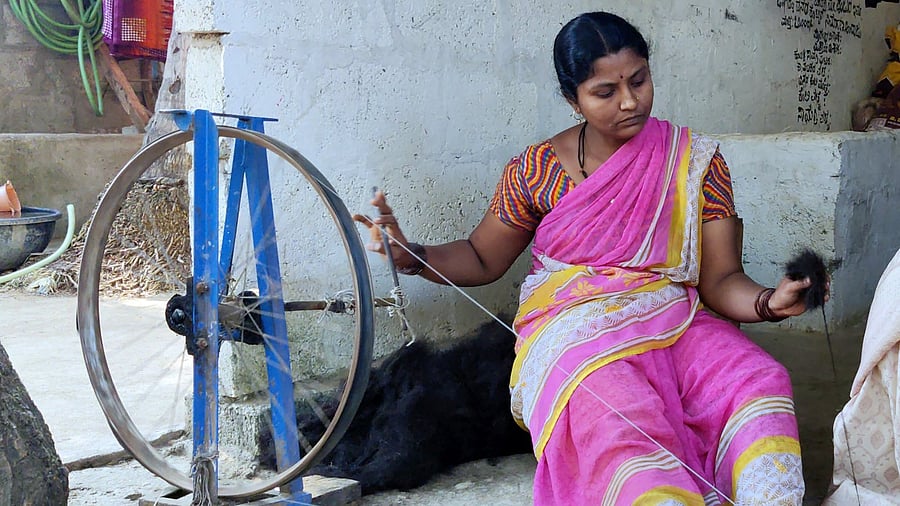
A woman spins yarn in Haveri; kambali makers display the finished product.
Credit: DH Photo
Winter is fast approaching, literally and figuratively, for Lakkappa Pujar, a sixth-generation kambali or sheep wool blanket manufacturer from Haveri’s Medleri village. It has been almost two years since he stopped making the famous kambali and tried to sell the remaining stocks.
“There is no market for kambalis now. I have some 40 kambalis, which I have been trying to sell for the past two years but I am unable to do so. After practising this profession for almost 40 years, I have moved on to run a grocery shop in my village,” he says.
Just a decade and a half ago, there were hundreds of kambali manufacturers in Lakkappa’s village. Almost all the houses used to have a ‘magga mane’ (weaving house) that wove kambalis, products once found in every home of North Karnataka due to their religious and cultural significance.
Today, Medleri has hardly 20 houses that consistently produce kambalis. A majority of the manufacturers have shifted to cultivation or work as labourers.
Karnataka’s kambalis were once manufactured in Belagavi, Haveri and Chalakeri and were famous across India. They were once a common feature in the Indian Army’s barracks, where soldiers used them to keep warm. However, today, machine-made Panipat wool blankets and sleeping bags have replaced the blankets.
Credit: DH Photo
A high-quality kambali was water-resistant and also provided warmth. This used to be a perfect choice for tea garden workers in the northeastern region of India and labourers in the Malnad region of Karnataka. However, today, even they have replaced kambalis, produced with wool from the Deccani sheep, indigenous to North Karnataka, with raincoats and synthetic covers.
“Manufacturing a kambali is tedious work. It would take two women and a man at least 10 hours to manufacture a blanket weighing 4 kg. We used to sell them for Rs 750 to Rs 1,200, depending upon the size and weight. However, now the machine-made wool blankets, which are sold for Rs 350 to Rs 500, have eaten into our market,” says Kariyappa Kolkar, an officebearer of the Medleri Wool Manufacturers’ Society.
Old-school process
Credit: DH Photo
Traditionally, the members of the Kuruba community manufactured kambalis. While the women of the house used to spin yarn, the men, standing in a 2x2 pit, would knit the blankets. “The uncertain market made me decide that my children should not continue this profession,” says Thippanna Giriyannavar, a kambali manufacturer from Ramdurg in Belagavi district.
The kambali makers, who have a history of over 1,000 years, say that the government has provided little support. “The army, government hostels and hotels used to be some of the largest consumers of our products. However, now the orders from the government have stopped,” says Thippanna.
Another major factor that resulted in the reduction in the production of kambalis is the changing agricultural climate, with farmers discouraging shepherds from penning their sheep in their fields. “Unless these sheep graze on varieties of grass, they will not produce a good quantity of wool,” says Kariyappa, who believes there is still hope of reviving the dying profession.
Pavithra Muddaya, founder of Vimor Handloom Foundation and Vimor Museum of Living Textiles, who is trying to revive kambalis, says there is a need to modernise the manufacturing process. Unless there are design and manufacturing interventions, revival and survival of kambalis will be difficult, she adds.